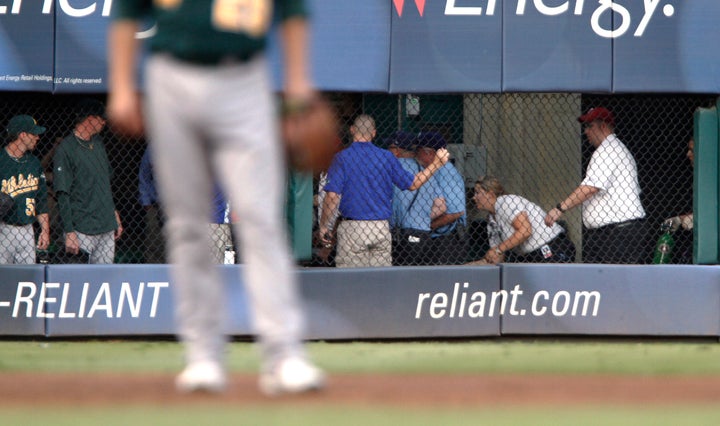
At every baseball stadium in America, there's a prohibition against throwing objects onto the field of play. It's grounds for immediate ejection from the event, a possible ban from the facility, and in some instances criminal prosecution. The basis for the prohibition is the fear of multi-million dollar corporations -- baseball teams -- that an unruly fan will cause physical damage to one of their investments, the ballplayers.
Incredibly, this prohibition regarding throwing things at baseball games doesn't work the other way: baseball teams design multi-tiered stadiums with low upper-deck railings and then permit their employees to throw all manner of objects into the stands. It's not just baseballs thrown by well-intentioned team employees like Josh Hamilton, it's the increasingly common phenomenon of teams effectuating trinket giveaways by catapulting or shotgunning such objects into the waiting crowd.
A few weeks ago I attended a ballgame at a National League park in the Eastern United States. I sat, along with some friends, in the first row of the second deck, and all of us noted how strangely low the railing was. Nor was there any netting or glass shielding of any kind. A man of average height, standing in front of the railing, would probably find that the bar was at a level slightly below his mid-thigh. During the break between the top and bottom of one of the innings a small corps of team employees ran onto the field to distribute t-shirts bearing the team logo to the crowd. The mechanism for this was a pneumatic gun whose range was such that any shot directed at the second deck would either just make -- or just miss -- the front row by a matter of feet. I said to one of my friends (and this was weeks before the Shannon Stone tragedy), "Someone's going to get killed here." And while there were no injuries at that game, within minutes of me noting the inherent dangerousness of the stadium's design and the team's promotional campaign, a t-shirt flew up to the second deck and a man in the front row reached dangerously far over that almost-thigh-high railing to grab a t-shirt. Had his balance been slightly worse he might well have fallen to his death.
Everyone who's ever attended a baseball game of any kind will agree that it's critical fans act with decorum; unruly fans, or fans who engage in any sort of dangerous behavior, are rightfully treated with suspicion, and sometimes scorn, by their fellow fans. Likewise, everyone who's a fan of Major League Baseball appreciates the generosity of the players in often thinking of fans first when discarding a baseball at the end of an inning or after a foul ball. These players are only doing what thousands of their predecessors have done in an effort to acknowledge the passion of the men, women, and children who attend America's baseball games. And yet, when a firefighter falls to his death in Texas trying to catch a ball tossed into the crowd, and the reaction of the stadium owners is to carefully bemoan the "tragedy" of the "accident," it doesn't take an attorney to understand how carefully those words are being parsed.
Every day, in baseball stadiums large and small around the country, both professional and minor-league stadiums, fans are placed in danger by good-natured home-team employees who have been explicitly asked or implicitly encouraged to toss or fire objects into crowds packed elbow-to-elbow into poorly-designed, unsafe stadiums. It's not just upper-deck fans who are at risk, but also, as in the case of Shannon Stone, those lower-deck fans whose reasonable expectation is that their hosts have not, do not, and will not endanger the lives of their corporation's consumers through ill-conceived promotional giveaways or even, yes, the time-honored tradition of the "gift" ball.
Baseball fans the nation over are deeply saddened by the recent events in Texas, but they ought not be shocked: there is a long history, in Major League Baseball, of such incidents at professional baseball stadiums, and clearly none of the previous deaths or injuries prevented the National League team whose game I attended recently from building their new stadium in the fashion they did. And whatever one's view of the wisdom of Shannon Stone's actions on the day of his death, certainly there can be no doubt that none of us want to see any more mournful-looking baseball-team executives stepping in front of a bank of cameras to speak of an "accident" which, we're to believe, could not possibly have been foreseen. Going forward, both fans and baseball players -- and even low-level team employees charged with executing basic promotion-related activities -- will need to exercise even greater caution than they have in the past. But baseball fans, baseball players, and chachka-slinging team lackeys are by no means the "bearers of least burden" when it comes to making stadium facilities and stadium culture safer for fans. Neither fans, players, or entry-level team employees design, build, or redesign stadiums, nor can they set team policies regarding on-field promotions and in-game player behavior. These responsibilities fall to individual teams' management corps. Let's hope that the next time a Nolan Ryan or the equivalent steps before an assemblage of cameras and microphones it's to announce a new team policy that ensures the safety of fans, not a series of attorney-vetted platitudes, which are as factually false as they are gravely disappointing.
Nothing in this article should be construed as legal advice to any person, persons, or organizations. If you believe you require the services of an attorney for reasons related or unrelated to the subject of this article, please locate an attorney in your area.
